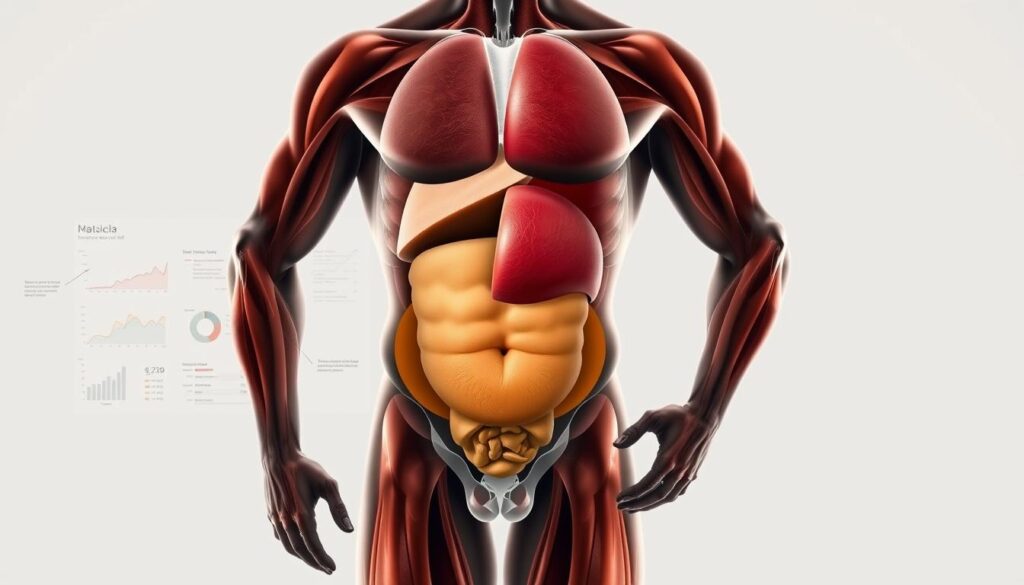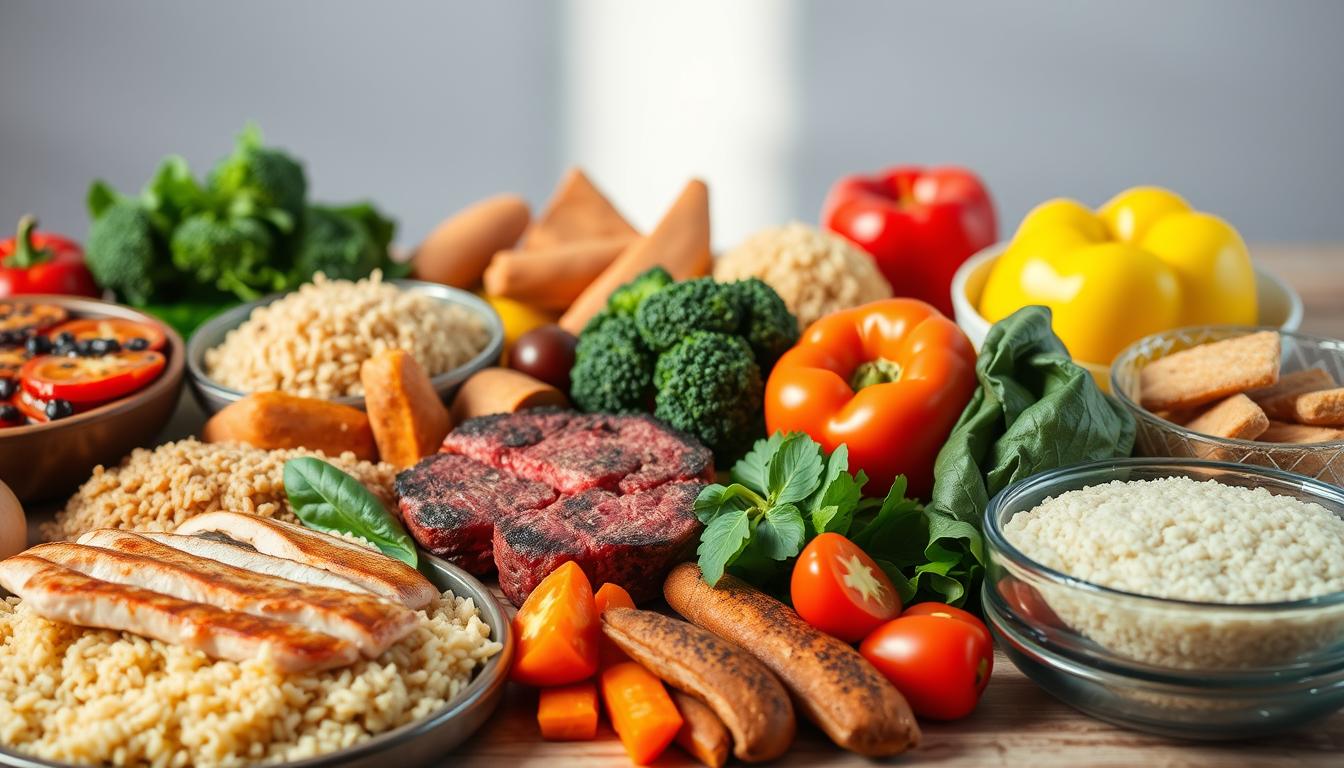Achieving fitness goals requires a combination of regular exercise and a well-structured nutrition plan. Did you know that a proper diet can account for up to 70% of your progress in muscle gain and fat loss? This underscores the importance of having a tailored diet plan that aligns with your fitness objectives.
A well-designed meal plan can help you achieve your goals more efficiently by ensuring you’re consuming the right balance of nutrients. This includes the optimal intake of proteins, carbohydrates, and fats to support muscle growth and fat loss.
Key Takeaways
- A proper nutrition plan is crucial for achieving fitness goals.
- A well-balanced diet can account for up to 70% of your progress.
- Tailoring your diet plan to your fitness objectives is essential.
- Optimal nutrient intake supports muscle growth and fat loss.
- A well-designed meal plan ensures the right balance of nutrients.
Understanding the Science Behind Body Composition
Achieving a lean, muscular physique requires a deep understanding of the physiological processes that govern body composition. This knowledge is crucial for developing effective muscle building meal plans and fat loss meal plans.
The Muscle Building Process
Muscle building, or hypertrophy, occurs when muscle fibers are subjected to stress, causing micro-tears that trigger a repair response. This process involves the activation of various cellular pathways that ultimately lead to muscle growth.
Protein Synthesis and Recovery
Protein synthesis is a critical component of muscle recovery and growth. Adequate protein intake provides the necessary building blocks for muscle repair, facilitating the recovery process and supporting the development of lean muscle.
Fat Loss Mechanisms
Fat loss occurs when the body burns more calories than it consumes, resulting in the utilization of stored fat for energy. This process is influenced by various factors, including diet, exercise, and metabolic rate.
Metabolic Factors That Influence Fat Burning
Metabolic factors, such as resting metabolic rate and thermogenesis, play a significant role in fat burning. A well-designed fat loss meal plan can help optimize these factors, supporting fat loss while preserving muscle mass.
The Challenge of Simultaneous Goals
Achieving simultaneous muscle gain and fat loss is challenging due to the conflicting demands of these goals. A well-structured meal plan that balances caloric intake and macronutrient ratios is essential for success.
| Physiological Process | Description | Influence on Body Composition |
|---|---|---|
| Muscle Protein Synthesis | Process by which muscles repair and grow | Essential for muscle gain |
| Fat Metabolism | Process by which fat is utilized for energy | Critical for fat loss |

“The key to achieving a lean, muscular physique is understanding how to balance muscle gain and fat loss through a combination of proper nutrition and training.”
Nutritional Fundamentals for Transforming Your Body
Nutrition plays a pivotal role in body transformation, affecting both muscle gain and fat loss. Understanding the nutritional fundamentals is crucial for achieving your fitness goals.
Optimal Macronutrient Ratios
The balance of macronutrients in your diet is essential for body transformation. Protein, carbohydrates, and fats each play unique roles.
Protein Requirements for Muscle Preservation
Adequate protein intake is vital for muscle preservation and growth, typically requiring 1.6 to 2.2 grams of protein per kilogram of body weight daily.
Strategic Carbohydrate and Fat Intake
Carbohydrates and fats are also crucial, with carbohydrates being a primary energy source and fats supporting hormone production. A balanced intake is key.
Caloric Requirements for Different Goals
Your caloric intake should be tailored to your specific goals. For muscle gain, a caloric surplus is necessary, while a caloric deficit is required for fat loss.
Timing Your Nutrition for Maximum Results
The timing of your meals can significantly impact your results. Pre-workout nutrition should focus on energy and muscle preservation, while post-workout nutrition is critical for recovery and muscle growth.
- Eat a balanced meal with protein and carbohydrates before your workout.
- Consume a mix of protein and carbohydrates within 30-60 minutes after your workout.
By understanding and applying these nutritional fundamentals, you can create a personalized nutrition plan that supports your body transformation goals.
Meal Plans for Muscle Gain and Fat Loss: Creating Your Custom Strategy
To effectively transform your body, you need a tailored nutritional strategy that aligns with your goals. Creating a meal plan that supports both muscle gain and fat loss requires a deep understanding of your body’s needs and how to meet them through nutrition.
Body Type Assessment and Goal Setting
The first step in creating your custom meal plan is assessing your body type and setting clear, achievable goals. Understanding whether you have an ectomorph, mesomorph, or endomorph body type will help you tailor your nutrition to your metabolic needs. Setting specific goals, such as gaining a certain amount of muscle or losing a specific percentage of body fat, will guide your nutritional strategy.
Calculating Your Personal Nutritional Needs
Calculating your daily nutritional needs is crucial for a successful meal plan. This involves determining your caloric intake and macronutrient distribution.
Adjusting Calories Based on Activity Level
Your activity level plays a significant role in determining your caloric needs. For instance, if you’re highly active, you’ll require more calories to support your energy expenditure. Adjusting your caloric intake based on your activity level ensures you’re fueling your body adequately for muscle gain and fat loss.
Protein, Carb, and Fat Distribution
The distribution of protein, carbohydrates, and fats in your diet is vital. Generally, a diet aimed at muscle gain and fat loss should be high in protein, moderate in carbohydrates, and balanced in healthy fats. A common distribution could be 40% protein, 30% carbohydrates, and 30% fat, but this can vary based on individual needs and goals.
| Nutrient | Muscle Gain Focus | Fat Loss Focus |
|---|---|---|
| Protein | 1.6-2.2 grams/kg body weight | 1.2-1.6 grams/kg body weight |
| Carbohydrates | 2-3 grams/kg body weight | 1-2 grams/kg body weight |
| Fats | 0.5-1 gram/kg body weight | 0.5-1 gram/kg body weight |
Structuring Meal Frequency and Timing
Meal frequency and timing can significantly impact your muscle gain and fat loss progress. Eating multiple meals throughout the day can help maintain a positive nitrogen balance, supporting muscle growth. Timing your meals around your workouts, such as having a protein-rich meal post-workout, can enhance recovery and muscle building.
By understanding your body type, calculating your nutritional needs, and structuring your meal frequency and timing, you can create a custom meal plan that effectively supports your muscle gain and fat loss goals.
Muscle-Building Meal Plan Templates
Developing a muscle-building meal plan involves understanding your nutritional needs and creating a tailored strategy. A well-structured meal plan is crucial for supporting muscle growth and recovery.
High-Protein Meal Options for Muscle Growth
High-protein meals are essential for muscle building. Include protein-rich foods like chicken, fish, eggs, and dairy products in your diet. For vegetarians, options like beans, lentils, and tofu are excellent alternatives. Aim for 1.2 to 1.6 grams of protein per kilogram of body weight daily to support muscle growth.
- Breakfast: Scrambled eggs with turkey bacon and whole-grain toast
- Lunch: Grilled chicken breast with quinoa and steamed vegetables
- Dinner: Baked salmon with sweet potato and green beans
Pre and Post-Workout Nutrition Strategies
Nutrition before and after workouts plays a critical role in muscle building. Consume a balanced meal with carbohydrates and protein 1-2 hours before your workout to provide energy. After your workout, replenish your energy stores with a mix of carbohydrates and protein within 30-60 minutes.
“Proper nutrition is the foundation of muscle building. Without adequate nutrients, your body cannot build muscle efficiently.”
Sample 7-Day Muscle Gain Meal Plan
A sample 7-day meal plan can help guide your nutrition. Here’s an example:
| Day | Breakfast | Lunch | Dinner |
|---|---|---|---|
| Monday | Oatmeal with banana and almond milk | Grilled chicken with brown rice | Salmon with quinoa and broccoli |
| Tuesday | Scrambled eggs with whole-grain toast | Turkey sandwich with avocado | Beef with roasted vegetables |
Adjustments for Hardgainers
For individuals who struggle to gain weight, increasing calorie intake is crucial. Add healthy fats like nuts and avocados to your meals. Additionally, consider supplementing with protein shakes to meet your daily protein needs.
Modifications for Different Training Schedules
If you have a variable training schedule, adjust your meal timing accordingly. Focus on maintaining a consistent daily nutrient intake, and adjust your pre and post-workout nutrition based on your training days.
Fat Loss Meal Plan Templates
Achieving fat loss while preserving lean muscle requires a strategic approach to nutrition. A well-designed meal plan is crucial for individuals aiming to lose fat without sacrificing muscle mass.
Calorie-Controlled Meals That Preserve Muscle
To lose fat while maintaining muscle, it’s essential to consume calorie-controlled meals that are rich in protein. Aim for a daily protein intake of at least 1.6 grams per kilogram of body weight to support muscle preservation. Incorporating lean protein sources like chicken, fish, and tofu into your meals can help achieve this goal.
Strategic Carbohydrate Timing for Fat Loss
Carbohydrate timing plays a significant role in fat loss. Consuming complex carbohydrates around your workout can help optimize your performance and support fat loss. Focus on whole grains, fruits, and vegetables as your primary carbohydrate sources.
Sample 7-Day Fat Loss Meal Plan
Here’s a sample 7-day meal plan designed for fat loss:
| Day | Breakfast | Lunch | Dinner |
|---|---|---|---|
| Monday | Oatmeal with Banana and Almond Milk | Grilled Chicken Breast with Quinoa and Vegetables | Baked Salmon with Sweet Potato and Green Beans |
| Tuesday | Scrambled Eggs with Spinach and Whole Wheat Toast | Turkey and Avocado Wrap with Mixed Greens | Grilled Turkey Breast with Brown Rice and Steamed Broccoli |
| Wednesday | Greek Yogurt with Berries and Almonds | Chicken Caesar Salad | Shrimp with Zucchini Noodles and Cherry Tomatoes |
Adjustments for Metabolic Adaptation
As your body adapts to your new diet, you may need to make adjustments to maintain progress. Regularly reassess your caloric needs and adjust your meal plan accordingly to avoid plateaus.
Meal Prep Tips for Consistency
Consistency is key to successful fat loss. Prepare your meals in advance to ensure you’re staying on track with your nutrition plan. Use containers to portion out your meals and keep healthy snacks on hand.
Conclusion: Implementing Your Meal Plan for Long-Term Success
A well-structured meal plan is crucial for achieving your fitness goals, whether you’re looking to gain muscle or lose fat. By understanding the science behind body composition and nutritional fundamentals, you can create a customized meal plan that suits your needs.
Effective meal plans for muscle gain and fat loss require a balanced approach to nutrition. A nutrition plan for muscle gain should focus on optimal macronutrient ratios, caloric requirements, and meal frequency. By structuring your nutrition strategy, you can support muscle growth and fat loss.
Consistency and patience are key to achieving long-term success. Stick to your meal plan, and you’ll be on your way to transforming your body. A well-planned nutrition strategy will help you reach your fitness goals.
